Nourhan El Sayed Fares: Stakeholder Analysis of Apple Inc. Report
VerifiedAdded on 2019/09/23
|6
|1098
|418
Report
AI Summary
This report provides a stakeholder analysis of Apple Inc., examining the company's approach to corporate social responsibility. It begins with a brief introduction to stakeholders in general and then focuses on Apple Inc., detailing its mission and vision. The report identifies key stakeholders including customers, employees, investors, and supply chain workers, and analyzes their respective interests. The analysis explores how Apple addresses the needs of each stakeholder group through its policies and strategies. The report highlights the importance of customer satisfaction, employee compensation and career development, and investor returns. It also considers the ethical practices within the supply chain. The conclusion emphasizes Apple's high performance in satisfying stakeholder interests and suggests areas for improvement, particularly in the supply chain's compliance with ethical standards. The report references several academic sources to support its analysis.
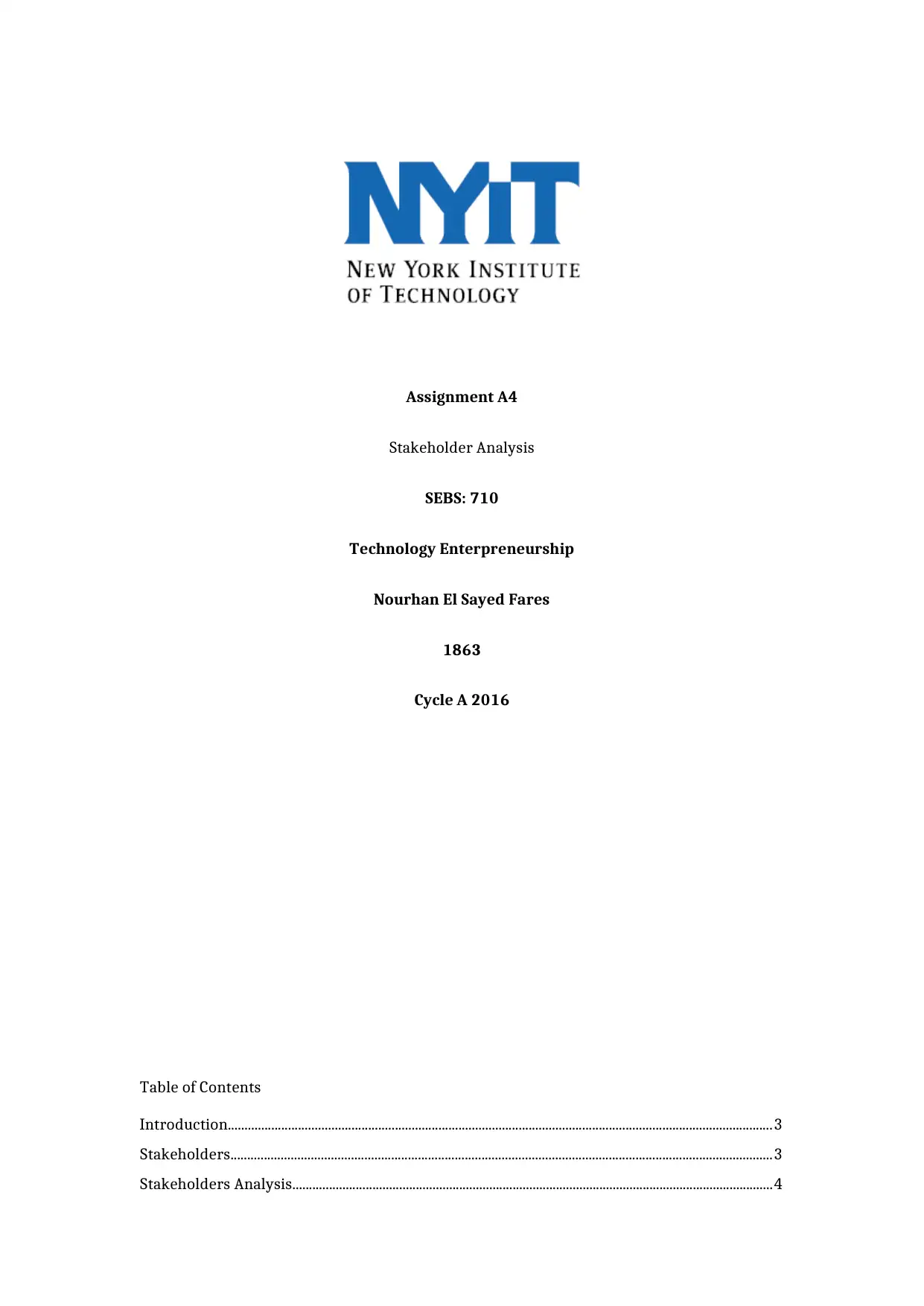
Assignment A4
Stakeholder Analysis
SEBS: 710
Technology Enterpreneurship
Nourhan El Sayed Fares
1863
Cycle A 2016
Table of Contents
Introduction...................................................................................................................................................................3
Stakeholders..................................................................................................................................................................3
Stakeholders Analysis................................................................................................................................................4
Stakeholder Analysis
SEBS: 710
Technology Enterpreneurship
Nourhan El Sayed Fares
1863
Cycle A 2016
Table of Contents
Introduction...................................................................................................................................................................3
Stakeholders..................................................................................................................................................................3
Stakeholders Analysis................................................................................................................................................4
Paraphrase This Document
Need a fresh take? Get an instant paraphrase of this document with our AI Paraphraser

Conclusion.......................................................................................................................................................................5
References.......................................................................................................................................................................6
References.......................................................................................................................................................................6
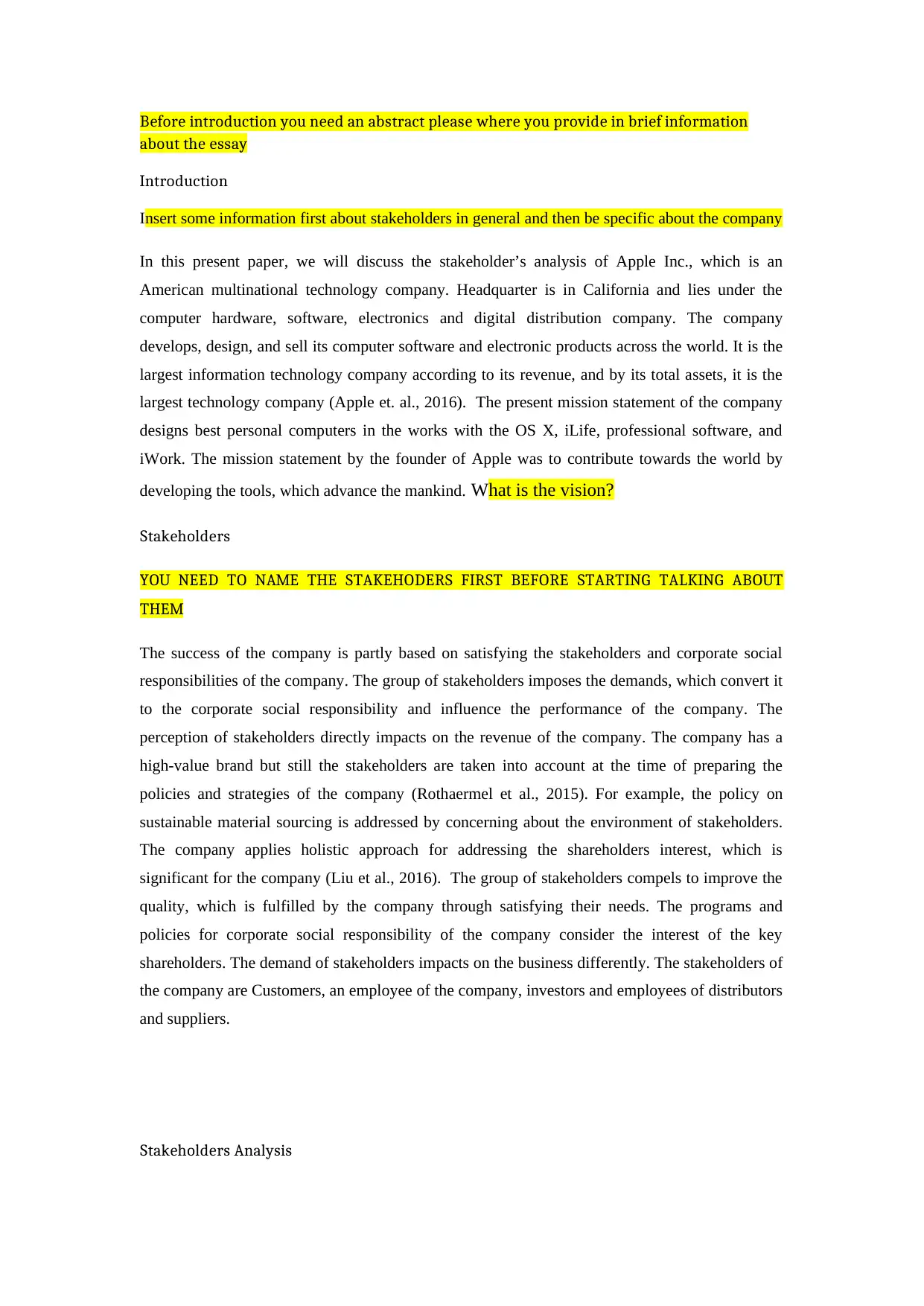
Before introduction you need an abstract please where you provide in brief information
about the essay
Introduction
Insert some information first about stakeholders in general and then be specific about the company
In this present paper, we will discuss the stakeholder’s analysis of Apple Inc., which is an
American multinational technology company. Headquarter is in California and lies under the
computer hardware, software, electronics and digital distribution company. The company
develops, design, and sell its computer software and electronic products across the world. It is the
largest information technology company according to its revenue, and by its total assets, it is the
largest technology company (Apple et. al., 2016). The present mission statement of the company
designs best personal computers in the works with the OS X, iLife, professional software, and
iWork. The mission statement by the founder of Apple was to contribute towards the world by
developing the tools, which advance the mankind. What is the vision?
Stakeholders
YOU NEED TO NAME THE STAKEHODERS FIRST BEFORE STARTING TALKING ABOUT
THEM
The success of the company is partly based on satisfying the stakeholders and corporate social
responsibilities of the company. The group of stakeholders imposes the demands, which convert it
to the corporate social responsibility and influence the performance of the company. The
perception of stakeholders directly impacts on the revenue of the company. The company has a
high-value brand but still the stakeholders are taken into account at the time of preparing the
policies and strategies of the company (Rothaermel et al., 2015). For example, the policy on
sustainable material sourcing is addressed by concerning about the environment of stakeholders.
The company applies holistic approach for addressing the shareholders interest, which is
significant for the company (Liu et al., 2016). The group of stakeholders compels to improve the
quality, which is fulfilled by the company through satisfying their needs. The programs and
policies for corporate social responsibility of the company consider the interest of the key
shareholders. The demand of stakeholders impacts on the business differently. The stakeholders of
the company are Customers, an employee of the company, investors and employees of distributors
and suppliers.
Stakeholders Analysis
about the essay
Introduction
Insert some information first about stakeholders in general and then be specific about the company
In this present paper, we will discuss the stakeholder’s analysis of Apple Inc., which is an
American multinational technology company. Headquarter is in California and lies under the
computer hardware, software, electronics and digital distribution company. The company
develops, design, and sell its computer software and electronic products across the world. It is the
largest information technology company according to its revenue, and by its total assets, it is the
largest technology company (Apple et. al., 2016). The present mission statement of the company
designs best personal computers in the works with the OS X, iLife, professional software, and
iWork. The mission statement by the founder of Apple was to contribute towards the world by
developing the tools, which advance the mankind. What is the vision?
Stakeholders
YOU NEED TO NAME THE STAKEHODERS FIRST BEFORE STARTING TALKING ABOUT
THEM
The success of the company is partly based on satisfying the stakeholders and corporate social
responsibilities of the company. The group of stakeholders imposes the demands, which convert it
to the corporate social responsibility and influence the performance of the company. The
perception of stakeholders directly impacts on the revenue of the company. The company has a
high-value brand but still the stakeholders are taken into account at the time of preparing the
policies and strategies of the company (Rothaermel et al., 2015). For example, the policy on
sustainable material sourcing is addressed by concerning about the environment of stakeholders.
The company applies holistic approach for addressing the shareholders interest, which is
significant for the company (Liu et al., 2016). The group of stakeholders compels to improve the
quality, which is fulfilled by the company through satisfying their needs. The programs and
policies for corporate social responsibility of the company consider the interest of the key
shareholders. The demand of stakeholders impacts on the business differently. The stakeholders of
the company are Customers, an employee of the company, investors and employees of distributors
and suppliers.
Stakeholders Analysis
⊘ This is a preview!⊘
Do you want full access?
Subscribe today to unlock all pages.

Trusted by 1+ million students worldwide
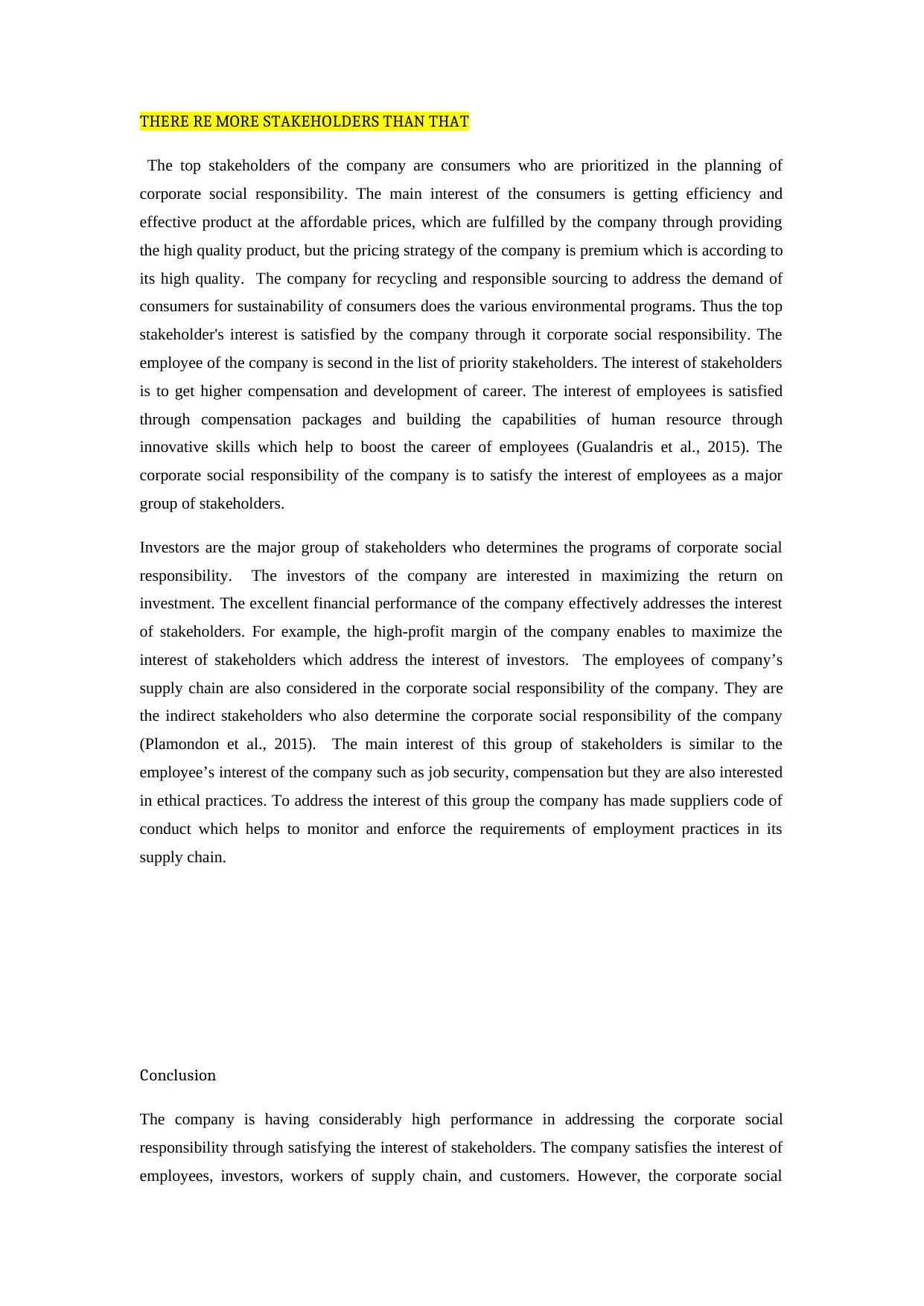
THERE RE MORE STAKEHOLDERS THAN THAT
The top stakeholders of the company are consumers who are prioritized in the planning of
corporate social responsibility. The main interest of the consumers is getting efficiency and
effective product at the affordable prices, which are fulfilled by the company through providing
the high quality product, but the pricing strategy of the company is premium which is according to
its high quality. The company for recycling and responsible sourcing to address the demand of
consumers for sustainability of consumers does the various environmental programs. Thus the top
stakeholder's interest is satisfied by the company through it corporate social responsibility. The
employee of the company is second in the list of priority stakeholders. The interest of stakeholders
is to get higher compensation and development of career. The interest of employees is satisfied
through compensation packages and building the capabilities of human resource through
innovative skills which help to boost the career of employees (Gualandris et al., 2015). The
corporate social responsibility of the company is to satisfy the interest of employees as a major
group of stakeholders.
Investors are the major group of stakeholders who determines the programs of corporate social
responsibility. The investors of the company are interested in maximizing the return on
investment. The excellent financial performance of the company effectively addresses the interest
of stakeholders. For example, the high-profit margin of the company enables to maximize the
interest of stakeholders which address the interest of investors. The employees of company’s
supply chain are also considered in the corporate social responsibility of the company. They are
the indirect stakeholders who also determine the corporate social responsibility of the company
(Plamondon et al., 2015). The main interest of this group of stakeholders is similar to the
employee’s interest of the company such as job security, compensation but they are also interested
in ethical practices. To address the interest of this group the company has made suppliers code of
conduct which helps to monitor and enforce the requirements of employment practices in its
supply chain.
Conclusion
The company is having considerably high performance in addressing the corporate social
responsibility through satisfying the interest of stakeholders. The company satisfies the interest of
employees, investors, workers of supply chain, and customers. However, the corporate social
The top stakeholders of the company are consumers who are prioritized in the planning of
corporate social responsibility. The main interest of the consumers is getting efficiency and
effective product at the affordable prices, which are fulfilled by the company through providing
the high quality product, but the pricing strategy of the company is premium which is according to
its high quality. The company for recycling and responsible sourcing to address the demand of
consumers for sustainability of consumers does the various environmental programs. Thus the top
stakeholder's interest is satisfied by the company through it corporate social responsibility. The
employee of the company is second in the list of priority stakeholders. The interest of stakeholders
is to get higher compensation and development of career. The interest of employees is satisfied
through compensation packages and building the capabilities of human resource through
innovative skills which help to boost the career of employees (Gualandris et al., 2015). The
corporate social responsibility of the company is to satisfy the interest of employees as a major
group of stakeholders.
Investors are the major group of stakeholders who determines the programs of corporate social
responsibility. The investors of the company are interested in maximizing the return on
investment. The excellent financial performance of the company effectively addresses the interest
of stakeholders. For example, the high-profit margin of the company enables to maximize the
interest of stakeholders which address the interest of investors. The employees of company’s
supply chain are also considered in the corporate social responsibility of the company. They are
the indirect stakeholders who also determine the corporate social responsibility of the company
(Plamondon et al., 2015). The main interest of this group of stakeholders is similar to the
employee’s interest of the company such as job security, compensation but they are also interested
in ethical practices. To address the interest of this group the company has made suppliers code of
conduct which helps to monitor and enforce the requirements of employment practices in its
supply chain.
Conclusion
The company is having considerably high performance in addressing the corporate social
responsibility through satisfying the interest of stakeholders. The company satisfies the interest of
employees, investors, workers of supply chain, and customers. However, the corporate social
Paraphrase This Document
Need a fresh take? Get an instant paraphrase of this document with our AI Paraphraser
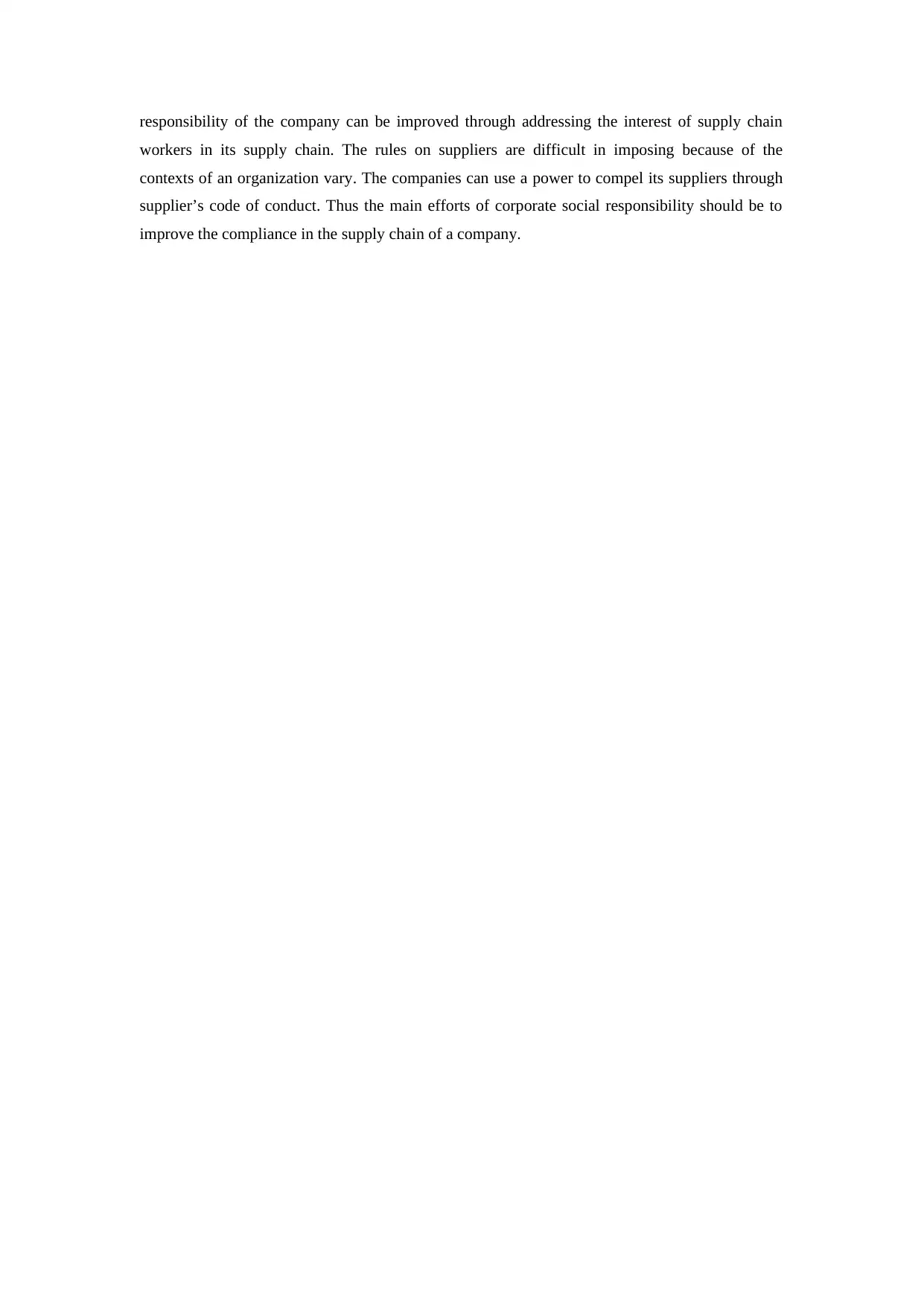
responsibility of the company can be improved through addressing the interest of supply chain
workers in its supply chain. The rules on suppliers are difficult in imposing because of the
contexts of an organization vary. The companies can use a power to compel its suppliers through
supplier’s code of conduct. Thus the main efforts of corporate social responsibility should be to
improve the compliance in the supply chain of a company.
workers in its supply chain. The rules on suppliers are difficult in imposing because of the
contexts of an organization vary. The companies can use a power to compel its suppliers through
supplier’s code of conduct. Thus the main efforts of corporate social responsibility should be to
improve the compliance in the supply chain of a company.
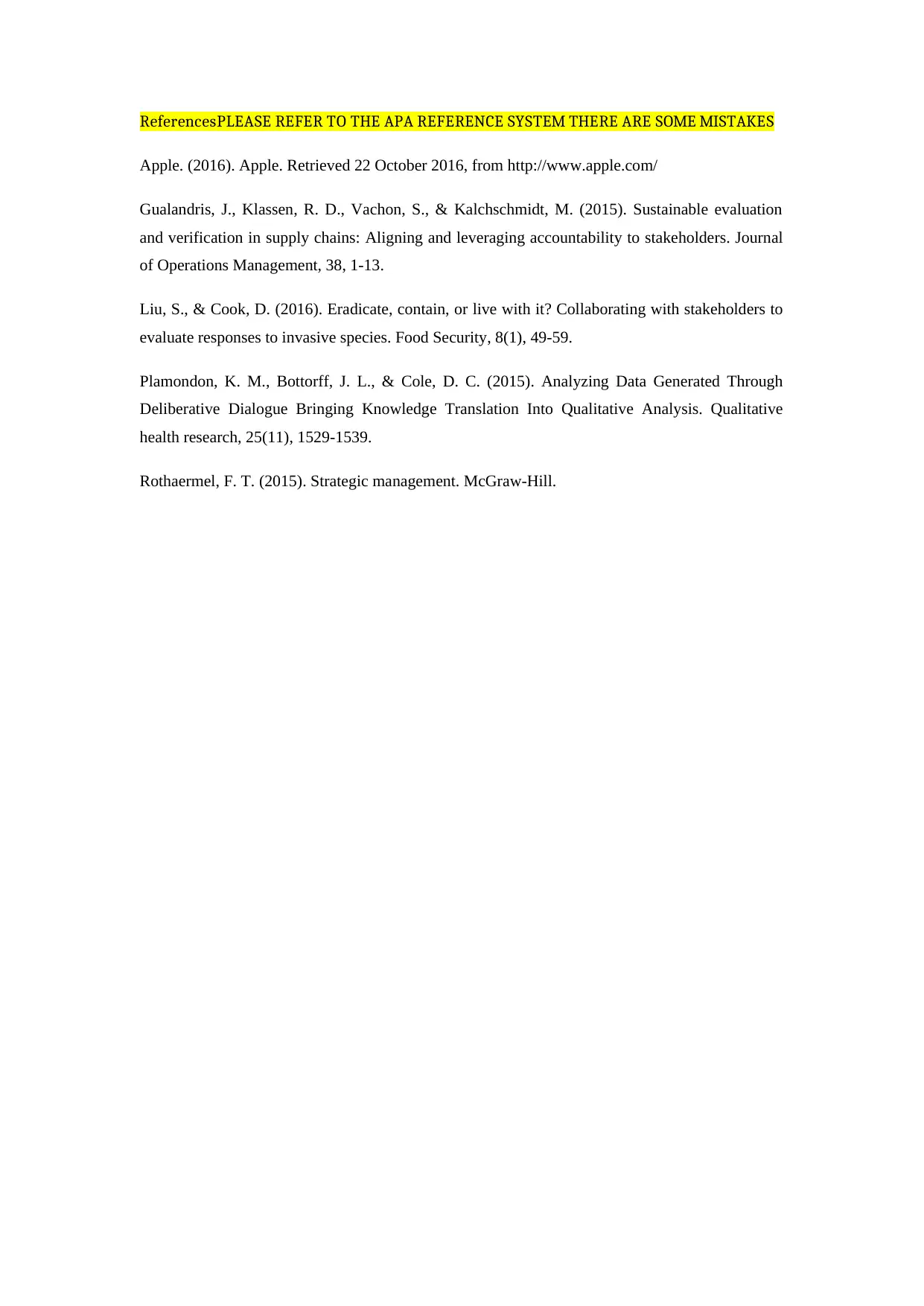
ReferencesPLEASE REFER TO THE APA REFERENCE SYSTEM THERE ARE SOME MISTAKES
Apple. (2016). Apple. Retrieved 22 October 2016, from http://www.apple.com/
Gualandris, J., Klassen, R. D., Vachon, S., & Kalchschmidt, M. (2015). Sustainable evaluation
and verification in supply chains: Aligning and leveraging accountability to stakeholders. Journal
of Operations Management, 38, 1-13.
Liu, S., & Cook, D. (2016). Eradicate, contain, or live with it? Collaborating with stakeholders to
evaluate responses to invasive species. Food Security, 8(1), 49-59.
Plamondon, K. M., Bottorff, J. L., & Cole, D. C. (2015). Analyzing Data Generated Through
Deliberative Dialogue Bringing Knowledge Translation Into Qualitative Analysis. Qualitative
health research, 25(11), 1529-1539.
Rothaermel, F. T. (2015). Strategic management. McGraw-Hill.
Apple. (2016). Apple. Retrieved 22 October 2016, from http://www.apple.com/
Gualandris, J., Klassen, R. D., Vachon, S., & Kalchschmidt, M. (2015). Sustainable evaluation
and verification in supply chains: Aligning and leveraging accountability to stakeholders. Journal
of Operations Management, 38, 1-13.
Liu, S., & Cook, D. (2016). Eradicate, contain, or live with it? Collaborating with stakeholders to
evaluate responses to invasive species. Food Security, 8(1), 49-59.
Plamondon, K. M., Bottorff, J. L., & Cole, D. C. (2015). Analyzing Data Generated Through
Deliberative Dialogue Bringing Knowledge Translation Into Qualitative Analysis. Qualitative
health research, 25(11), 1529-1539.
Rothaermel, F. T. (2015). Strategic management. McGraw-Hill.
⊘ This is a preview!⊘
Do you want full access?
Subscribe today to unlock all pages.

Trusted by 1+ million students worldwide
1 out of 6
Related Documents
Your All-in-One AI-Powered Toolkit for Academic Success.
+13062052269
info@desklib.com
Available 24*7 on WhatsApp / Email
![[object Object]](/_next/static/media/star-bottom.7253800d.svg)
Unlock your academic potential
Copyright © 2020–2025 A2Z Services. All Rights Reserved. Developed and managed by ZUCOL.




